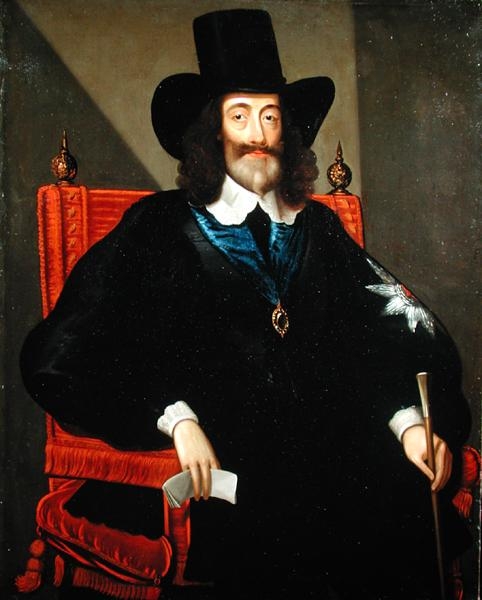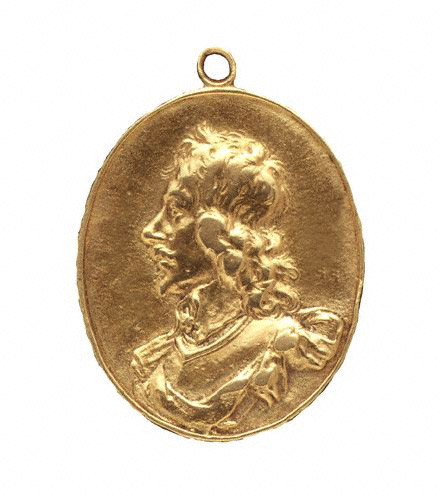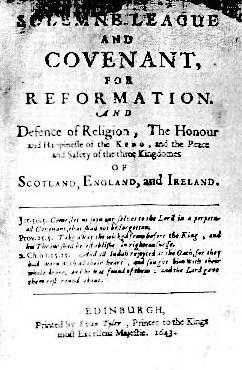|
Army Council (1647)
The Army Council was a body established in 1647 to represent the views of all levels of the New Model Army. It originally consisted of senior commanders, like Sir Thomas Fairfax, and representatives elected by their regiments, known as Agitators. Following the Putney Debates of October to November 1647, Fairfax, Oliver Cromwell and Henry Ireton grew concerned by their radicalism, and in 1648, Agitators were removed from the Council. Now dominated by the so-called Grandees, it became the Council of Officers. Background When the First English Civil War began in 1642, the vast majority on both sides believed a 'well-ordered' monarchy was divinely mandated. They disagreed on what 'well-ordered' meant, and who held ultimate authority in clerical affairs. Royalists generally supported a Church of England governed by bishops, appointed by, and answerable to, the king; Puritans believed he was answerable to the leaders of the church, appointed by their congregations. However, ' ... [...More Info...] [...Related Items...] OR: [Wikipedia] [Google] [Baidu] |
Thomas Fairfax
Sir Thomas Fairfax (17 January 1612 – 12 November 1671) was an English army officer and politician who commanded the New Model Army from 1645 to 1650 during the English Civil War. Because of his dark hair, he was known as "Black Tom" to his loyal troops. He was the eldest son and heir of Ferdinando Fairfax, 2nd Lord Fairfax of Cameron, (Lord Fairfax) and succeeded to that title as 3rd Lord Fairfax in 1648 on the death of his father, although he was generally known as "Sir Thomas Fairfax" to distinguish them. He adopted the profession of arms as a young man, when he served under Horace Vere, 1st Baron Vere of Tilbury, Horace Vere in the Netherlands. In 1637, he married Vere's daughter Anne. Fairfax was recalled to English service in 1639, for the first of King Charles' disastrous Bishops' Wars against Scotland. When these defeats led to the outbreak of the Civil War in 1642, Lord Fairfax declared for Parliament and was named general of Parliament's forces in the north, with Sir ... [...More Info...] [...Related Items...] OR: [Wikipedia] [Google] [Baidu] |
Church Of Scotland
The Church of Scotland (CoS; ; ) is a Presbyterian denomination of Christianity that holds the status of the national church in Scotland. It is one of the country's largest, having 245,000 members in 2024 and 259,200 members in 2023. While membership in the church has declined significantly in recent decades (in 1982 it had nearly 920,000 members), the government Scottish Household Survey found that 20% of the Scottish population, or over one million people, identified the Church of Scotland as their religious identity in 2019. In the 2022 census, 20.4% of the Scottish population, or 1,108,796 adherents, identified the Church of Scotland as their religious identity. The Church of Scotland's governing system is Presbyterian polity, presbyterian in its approach, therefore, no one individual or group within the church has more or less influence over church matters. There is no one person who acts as the head of faith, as the church believes that role is the "Lord God's". As a pro ... [...More Info...] [...Related Items...] OR: [Wikipedia] [Google] [Baidu] |
Newmarket, Suffolk
Newmarket is a market town and civil parish in the West Suffolk (district), West Suffolk district of Suffolk, England, 14 miles west of Bury St Edmunds and 14 miles northeast of Cambridge. In 2021, it had a population of 16,772. It is a global centre for thoroughbred horse race, thoroughbred horse racing, racehorse training, breeding, and horse health. Two Classic races and three British Champions Series races are held at Newmarket every year. The town has had close royal connections since the time of James I of England, James I, who built a palace there, and was also a base for Charles I of England, Charles I, Charles II of England, Charles II, and most monarchs since. Elizabeth II visited the town often to see her horses in training. Newmarket has over fifty horse training stables, two large racetracks, the Rowley Mile and the Newmarket Racecourse, July Course, and one of the most extensive and prestigious horse training grounds in the world. The town is home to over 3,500 rac ... [...More Info...] [...Related Items...] OR: [Wikipedia] [Google] [Baidu] |
Grandee (New Model Army)
Grandee (; , ) is an official aristocratic title conferred on some Spanish nobility. Holders of this dignity enjoyed similar privileges to those of the peerage of France during the , though in neither country did they have the significant constitutional political role the House of Lords gave to the Peerage of England, of Great Britain and of the United Kingdom. A "grandee of Spain" nonetheless enjoyed greater social privileges than those of other similar European dignities. With the exception of Fernandina, all Spanish dukedoms are automatically attached to a grandeeship, yet only a few marquessates, countships, viscountcies, baronies and lordships have the distinction. A single person can be a grandee of Spain multiple times, as grandeeships are attached, except in a few cases, to a title and not an individual. Such grandees with more than one title notably include the current Duchess of Medinaceli and the Duke of Alba, who are grandees ten and nine times respectivel ... [...More Info...] [...Related Items...] OR: [Wikipedia] [Google] [Baidu] |
Thomas Fairfax, 3rd Lord Fairfax Of Cameron
Sir Thomas Fairfax (17 January 1612 – 12 November 1671) was an English army officer and politician who commanded the New Model Army from 1645 to 1650 during the English Civil War. Because of his dark hair, he was known as "Black Tom" to his loyal troops. He was the eldest son and heir of Ferdinando Fairfax, 2nd Lord Fairfax of Cameron, (Lord Fairfax) and succeeded to that title as 3rd Lord Fairfax in 1648 on the death of his father, although he was generally known as "Sir Thomas Fairfax" to distinguish them. He adopted the profession of arms as a young man, when he served under Horace Vere in the Netherlands. In 1637, he married Vere's daughter Anne. Fairfax was recalled to English service in 1639, for the first of King Charles' disastrous Bishops' Wars against Scotland. When these defeats led to the outbreak of the Civil War in 1642, Lord Fairfax declared for Parliament and was named general of Parliament's forces in the north, with Sir Thomas his second-in command. Sir Tho ... [...More Info...] [...Related Items...] OR: [Wikipedia] [Google] [Baidu] |
Royal Navy
The Royal Navy (RN) is the naval warfare force of the United Kingdom. It is a component of His Majesty's Naval Service, and its officers hold their commissions from the King of the United Kingdom, King. Although warships were used by Kingdom of England, English and Kingdom of Scotland, Scottish kings from the early Middle Ages, medieval period, the first major maritime engagements were fought in the Hundred Years' War against Kingdom of France, France. The modern Royal Navy traces its origins to the English Navy of the early 16th century; the oldest of the British Armed Forces, UK's armed services, it is consequently known as the Senior Service. From the early 18th century until the World War II, Second World War, it was the world's most powerful navy. The Royal Navy played a key part in establishing and defending the British Empire, and four Imperial fortress colonies and a string of imperial bases and coaling stations secured the Royal Navy's ability to assert naval superior ... [...More Info...] [...Related Items...] OR: [Wikipedia] [Google] [Baidu] |
Rowland Laugharne
Major General Rowland Laugharne (1607 – 1675) was a member of the Welsh gentry, and a prominent soldier during the Wars of the Three Kingdoms, in which he fought on both sides. Laugharne began his career as a page to Robert Devereux, 3rd Earl of Essex, and may have served with him in the Dutch war with Spain. Along with John Poyer and Rice Powell, he led Parliamentarian forces in Pembrokeshire during the 1642 to 1646 First English Civil War, from 1643 until the Royalists surrendered in June 1646. A social conservative, he supported moderate Parliamentarians who wanted a negotiated settlement with Charles I, and opposed radicals within the New Model Army. In the Second English Civil War, he fought for the Royalists, but was defeated at the Battle of St Fagans in May 1648. Condemned to death with Poyer and Powell, he was reprieved after the three drew lots; Poyer lost, and was executed shortly afterwards. After the 1660 Restoration, he was elected to the Cavalier ... [...More Info...] [...Related Items...] OR: [Wikipedia] [Google] [Baidu] |
Trained Bands
Trained Bands were companies of part-time militia in England, Wales and the Americas.Jonathan Worton: Ludlow's Trained Band: A Study of Militiamen in Early Stuart England, ''Journal of the Society for Army Historical Research'', Vol. 91, No. 365 (Spring 2013), pp. 4–23, , last accessed 27 Oct 2018: "Two dozen militiamen—12 equipped as musketeers, 12 as pikemen—who dutifully assembled at Ludlow for the muster on 8 May 1632 constituted the town's Trained Band, a unit maintained at the charge of Ludlow's inhabitants with its ranks filled by local men." first organized in the 16th century and dissolved in the 18th. The term was used after this time to describe the London militia. In England and Wales, organised by county, they were supposed to drill on a regular basis, although this was rarely the case in practice. The regular army was formed from the Trained Bands in the event of war, though the inability or unwillingness of many of the bands to serve outside of their home regio ... [...More Info...] [...Related Items...] OR: [Wikipedia] [Google] [Baidu] |
Charles I Of England
Charles I (19 November 1600 – 30 January 1649) was King of Kingdom of England, England, Kingdom of Scotland, Scotland, and Kingdom of Ireland, Ireland from 27 March 1625 until Execution of Charles I, his execution in 1649. Charles was born into the House of Stuart as the second son of King James VI of Scotland, but after his father inherited the English throne in 1603, he moved to England, where he spent much of the rest of his life. He became heir apparent to the kingdoms of England, Scotland, and Ireland in 1612 upon the death of his elder brother, Henry Frederick, Prince of Wales. An unsuccessful and unpopular attempt to marry him to Infanta Maria Anna of Spain culminated in an eight-month visit to Habsburg Spain, Spain in 1623 that demonstrated the futility of the marriage negotiation. Two years later, shortly after his accession, he married Henrietta Maria of France. After his accession in 1625, Charles quarrelled with the English Parliament, which sought to curb his ro ... [...More Info...] [...Related Items...] OR: [Wikipedia] [Google] [Baidu] |
Levellers
The Levellers were a political movement active during the English Civil War who were committed to popular sovereignty, extended suffrage, equality before the law and religious tolerance. The hallmark of Leveller thought was its populism, as shown by its emphasis on equal natural rights, and their practice of reaching the public through pamphlets, petitions and vocal appeals to the crowd. The Levellers came to prominence at the end of the First English Civil War (1642–1646) and were most influential before the start of the Second English Civil War, Second Civil War (1648–49). Leveller views and support were found in the populace of the City of London and in some regiments in the New Model Army. Their ideas were presented in their manifesto "Agreement of the People". In contrast to the Diggers, the Levellers opposed common ownership, except in cases of mutual agreement of the property owners. They were organised at the national level, with offices in a number of London inns ... [...More Info...] [...Related Items...] OR: [Wikipedia] [Google] [Baidu] |
Solemn League And Covenant
The Solemn League and Covenant was an agreement between the Scottish Covenanters and the leaders of the English Parliamentarians in 1643 during the First English Civil War, a theatre of conflict in the Wars of the Three Kingdoms. On 17 August 1643, the Church of Scotland (the Kirk) accepted it and on 25 September 1643 so did the English Parliament and the Westminster Assembly. English Parliament (First Civil War) At the time, the Protestant leaders of the English Parliament were in conflict with King Charles I. Fearing Irish Catholic troops could join the Royalist army, Parliament requested the aid of the Scots. The Presbyterian Covenanters promised their aid, on condition that the Scottish system of church government was adopted in England. This was acceptable to the majority of the English Long Parliament, as many MPs were Presbyterians, while others preferred allying with the Scots rather than losing the Civil War. After some haggling a document called "'' The Solemn ... [...More Info...] [...Related Items...] OR: [Wikipedia] [Google] [Baidu] |






